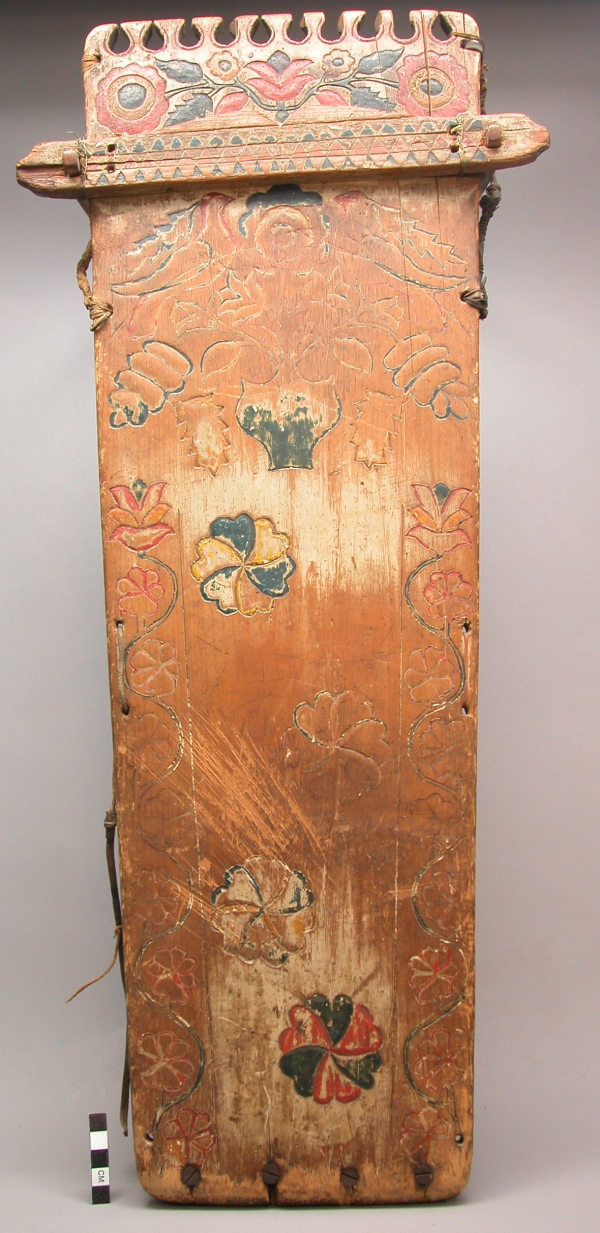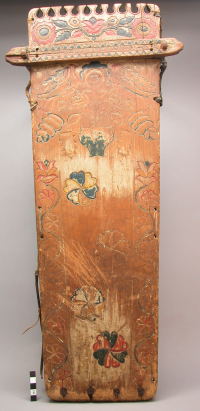káhrhon cradleboard
káhrhon cradleboard
káhrhon cradleboard


The headboard and footrest are fastened to the frame with sinew. The wooden back is long and narrow. The reverse side of the cradleboard (káhrhon) has carvings and paintings of flowers, stems, and symmetrical motifs.
The Peabody Museum of Archaeology and Ethnology.
The construction and design of cradleboards (káhrhon) are passed from generation to generation.
Read More About This Relative
Wood, Pigment, Leather, Metal, and Fiber.
The backboard is a plank of cedar or birch. A crossbar piece is soaked and carefully bent. The crossbar protects the child and can be used as a handle to lift or to hang sacred items or ornaments. On the back of the cradleboard (káhrhon) are carved, or painted motifs of hearts or geometric symbols. The family's women help sew the covering using hide, cloth, sinew, thread, beads, embroidery, and porcupine quills. The pattern's design was passed down from grandmother to mother to granddaughter. Some communities had members who could recognize these families' beaded designs and symbols because the designs represent family stories and clans.
The photo displays the cradleboard's (káhrhon) back view. The back view is incised and painted with flowers, stems and a series of triangular shapes. Each flower incorporates six heart shapes. The tops of the hearts stand in for the petalled ends of the flowers, and the cones swirl at the centres of the flowers. The water droplet shapes in the negative spaces between the fantails make up the dentil feature along the top of the cradleboard. Women are the water carriers and babies are surrounded by water in the womb. All First Nations recognize how water represents the life blood of the earth.
The geometric shapes on the cardboard's head board (káhrhon) represents traditional symbols from the artist's dream, political position, or family clan. The shapes used to create the flowers and stems are sometimes the same shapes in the syllabic alphabet.
Traditionally, the cradleboard served multiple purposes. Its primary purpose was to safely carry the baby on the mother's back while she worked or moved from one camp to another. Both mother and baby would accompany each other while harvesting berries and medicine. The baby was laced into the cradleboard under a protective covering. This protected the baby from the underbrush and insects. Its secondary purpose was childcare. The cradleboard was used to keep the baby near the mother and was usually placed against the trunk of a tree or hung from a branch. From this vantage point, the baby could watch the mother, the environment, social interactions and the animals. The cradleboard is constructed with a crash bar. This handlebar protects the baby from falls. A third benefit was how the cradleboard kept the baby's back and legs straight. This cradleboard (káhrhon) was collected and enjoyed as an ornament, and later it was donated as an example of material culture to the Fellows of Harvard College, the Peabody Museum of Archaeology and Ethnology.
Provenance
Mrs. Richard Pearson Strong collected the cradleboard (káhrhon), then later, John G. Green acquired it. Then, he donated to the President and Fellows of Harvard College, the Peabody Museum of Archaeology and Ethnology.
John G. Greene gifted the President and Fellows of Harvard College, a cradleboard (káhrhon) to display in the Peabody Museum of Archaeology and Ethnology.
About This GRASAC Record







Kanyen'kehà:ka -(Mohawk), The Peabody Museum of Archaeology and Ethnology.
 Knowledge Sharing Platform
Knowledge Sharing Platform

